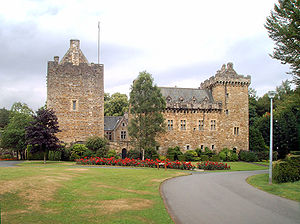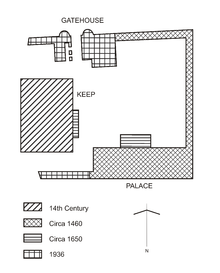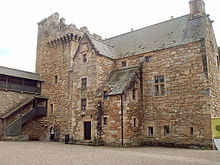Dean Castle
| Dean Castle | ||
|---|---|---|
|
South view of Dean Castle |
||
| Creation time : | around 1350 | |
| Castle type : | Residential tower with inner courtyard | |
| Conservation status: | restored | |
| Geographical location | 55 ° 37 '23.9 " N , 4 ° 29' 2" W | |
|
|
||
Dean Castle (from around 1700 also Kilmarnock Castle ) is located in the Dean Castle Country Park near Kilmarnock , East Ayrshire , Scotland . The name comes from "The Dean", a Scottish name for a wooded valley. The castle is the ancestral home of the Boyd family. Even before the appointment as barons , the head of the family was also the hereditary chief of Clan Boyd and had been Lord of Kilmarnock for centuries.
Dean Castle has a close relationship with eminent figures and notable events in Scottish history: King Robert I 'the Bruce' gave the land to the Boyd family in thanks for their service at the Battle of Bannockburn ; King Jacob III Sister Mary married into the family; some important covenanters were imprisoned here; Bonnie Prince Charlie's rebellion was supported by William, 4th Earl of Kilmarnock . Robert Burns was encouraged here by the then owner, the Earl of Glencairn, to publish his works.
history
For his service at the Battle of Bannockburn, Robert Boyd was rewarded by King Robert I in 1316 with the lands of Kilmarnock and West Kilbride.
The keep
The keep was built around 1350 by Thomas Boyd, son of Robert Boyd. Four stories high and with walls 2 to 3 meters thick, it was mainly used for defense. The original entrance was on the first floor. Extremely unusual for Scottish castles at this time is the complete absence of loopholes.
There were two rooms on the ground floor: the original kitchen for entertaining guests in the “Great Hall” above and the dungeon . Both rooms, which were to be regarded as basements, could only be entered from the first floor via a ladder.
The first floor contained the "Great Hall" called the great hall with a high vaulted ceiling. It served as the courtroom for the Lords of Kilmarnock; but also for entertainment and celebrations, as a minstrel gallery shows. Guests present as well as traveling minstrels also use the hall as a dormitory.
A second, smaller room served as a guard room, which was always manned by soldiers. Both the only access to the tower and the access to the dungeon via a fear hole were to be found here.
On the second floor there was a large room called "Solar". It was used for private events and could be divided into a women's and a men's area by means of a curtain. Each of the two areas had its own fireplace. In addition, a small private chapel and a hairdressing room were set up on this floor.
On the third floor there were a few small rooms that the soldiers used as living rooms and bedrooms. Most of it, however, was taken up by an open area from which archers could fire at a possible attacker.
The palace
The palace-like building was built by Robert Boyd after his appointment as 1st Lord Boyd of Kilmarnock in 1454, probably shortly after 1460.
The palace was designed mainly with comfort in mind. On the ground floor was the kitchen with a large fireplace and additional stoves. The first floor contained only the huge banquet hall, while the second floor contained private bedrooms. The original staircase to the first floor was outside the building and was made of wood; it was later replaced by an internal stone staircase.
However, the defense was not completely ignored: part of the palace was planned as a tower and called the Laigh or Low Tower , it is lower than the keep. The tower contained the private rooms of the Lord of Kilmarnock and also had protruding platforms for soldiers. The entire property was also surrounded by a curtain wall, and the resulting inner courtyard housed stables, warehouses and the forge.
The castle today
In 1735 a fire broke out in the palace kitchen. It spread quickly, destroyed almost the entire building and also spread to the roof of the keep. However, the owner, William Boyd, 4th Earl of Kilmarnock, had financial difficulties at the time and was unable to repair the castle. Dean Castle was sold by William's son James in 1746 and faced two centuries of neglect by changing owners, even though part of the outbuildings were still in use.
It was not until Thomas Scott-Ellis, 8th Baron Howard de Walden, began restoring the castle. In 1908 the keep was completed; work on the palace dragged on until shortly before his death in 1946. The wooden battlement was also added in the course of these restorations.
In the years 1935 and 1936, the gatehouse that can be found today was built, which had not existed in this form before. It is a careful copy of a real 16th century building; the design and decorative but functional loopholes were copied from Tolquhon Castle . The attention to detail is also evident in the windows, half of which are made of lead-glazed panes and the other half of wooden shutters.
In 1975, John, 9th Baron Howard de Walden, donated the castle and the entire property to the people of Kilmarnock. This also included his father's weapons and armaments collection and his grandfather's collection of musical instruments.
Dean Castle and the associated Country Park are now administered by the East Ayrshire Council and the castle is used as a museum. The exhibition of weapons and armor can be found in the “Great Hall” in the keep, the collection of musical instruments is presented in the “Solar”.
Various works of art can be seen in the palace, including a large bust of William Wallace on the ground floor. The banquet hall features various East Ayrshire Council exhibits, including a. the Kilmarnock Edition of Robert Burns poetry ; a full-scale model of the castle can be found in the Earl of Kilmarnock's private room in the Low Tower .
Trivia
William Boyd, 4th Earl of Kilmarnock, was charged with his involvement in the Second Jacobite Rising and was executed in London on August 18, 1746 for high treason. Legends say that after the beheading his head was brought back to Dean Castle in a box and is still in the Laigh Tower today . His ghost has been around since then, which is said to have moved some "ghost hunters" to intensive investigations in the castle.
The "Robert Burns World Federation" had a plaque attached to the castle in memory of the victims of the terrorist attacks on September 11, 2001 . You can read:
Dedicated to the victims of terrorism in the USA on September 11th, 2001 "Man's Inhumanity to man Makes countless thousands mourn!" Robert Burns (1759-1796)
literature
- Archibald R. Adamson: Rambles round Kilmarnock: with an introductory sketch of the town . Stevenson, Kilmarnock 1875 ( online at www.archive.org [accessed September 21, 2014]).
- Mike Salter: The Castles of South West Scotland . Folly Publications, Malvern 1993.
Web links
- Dean Castle and Country Park. East Ayrshire Leisure, accessed September 21, 2014 (look for Dean Castle ).
- Dean Castle. The Lordship & Barony of Kilmarnock, accessed September 21, 2014 .
Individual evidence
- ^ Robert Boyd, 1st Lord Boyd of Kilmarnock on thepeerage.com , accessed September 17, 2016.





